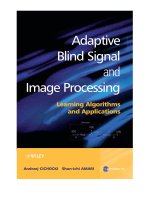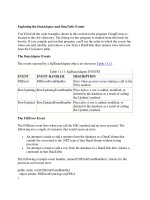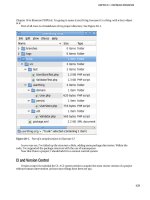Tài liệu 74 Morphological Signal and Image Processing docx
Bạn đang xem bản rút gọn của tài liệu. Xem và tải ngay bản đầy đủ của tài liệu tại đây (390.28 KB, 32 trang )
Petros Maragos. “Morphological Signal and Image Processing.”
2000 CRC Press LLC. <>.
MorphologicalSignalandImage
Processing
PetrosMaragos
GeorgiaInstituteofTechnology
74.1Introduction
74.2MorphologicalOperatorsforSetsandSignals
BooleanOperatorsandThresholdLogic
•
MorphologicalSet
Operators
•
MorphologicalSignalOperatorsandNonlinear
Convolutions
74.3Median,Rank,andStackOperators
74.4UniversalityofMorphologicalOperators
74.5MorphologicalOperatorsandLatticeTheory
74.6SlopeTransforms
74.7MultiscaleMorphologicalImageAnalysis
BinaryMultiscaleMorphologyviaDistanceTransforms
•
Mul-
tiresolutionMorphology
74.8DifferentialEquationsforContinuous-ScaleMorphology
74.9ApplicationstoImageProcessingandVision
NoiseSuppression
•
FeatureExtraction
•
ShapeRepresentation
viaSkeletonTransforms
•
ShapeThinning
•
SizeDistributions
•
Fractals
•
ImageSegmentation
74.10Conclusions
Acknowledgment
References
74.1 Introduction
Thischapterprovidesabriefintroductiontothetheoryofmorphologicalsignalprocessingandits
applicationstoimageanalysisandnonlinearfiltering.By“morphologicalsignalprocessing”wemean
abroadandcoherentcollectionoftheoreticalconcepts,mathematicaltoolsforsignalanalysis,non-
linearsignaloperators,designmethodologies,andapplicationssystemsthatarebasedonorrelated
tomathematicalmorphology(MM),aset-andlattice-theoreticmethodologyforimageanalysis.MM
aimsatquantitativelydescribingthegeometricalstructureofimageobjects.Itsmathematicalorigins
stemfromsettheory,latticealgebra,convexanalysis,andintegralandstochasticgeometry.Itwas
initiatedmainlybyMatheron[42]andSerra[58]inthe1960s.Someofitsearlysignaloperationsare
alsofoundintheworkofotherresearcherswhousedcellularautomataandBoolean/thresholdlogic
toanalyzebinaryimagedatainthe1950sand1960s,assurveyedin[49,54].MMhasformalized
theseearlieroperationsandhasalsoaddednumerousnewconceptsandimageoperations.Inthe
1970sitwasextendedtogray-levelimages[22,45,58,62].OriginallyMMwasappliedtoanalyzing
c
1999byCRCPressLLC
images from geological or biological specimens. However, its rich theoretical framework, algorith-
mic efficiency, easy implementability on special hardware, and suitability for many shape-oriented
problems have propelled its widespread diffusion and adoption by many academic and industry
groups in many countries as one among the dominant image analysis methodologies. Many of these
research groups have also extended the theory and applications of MM. As a result, MM nowadays
offers many theoretical and algorithmic tools to and inspires new directions in many research areas
from the fields of signal processing, image processing and machine vision, and pattern recognition.
Asthename‘morphology’ implies(study/analysisof shape/form), morphological signal processing
can quantify the shape, size, and other aspects of the geometrical structure of signals viewed as image
objects, in a rigorous way that also agrees with human intuition and perception. In contrast, the
traditional tools of linear systems and Fourier analysis are of limited or no use for solving geometry-
based problems in image processing because they do not directly address the fundamental issues of
how to quantify shape, size, or other geometrical structures in signals and may distort important
geometrical featuresinimages. Thus,morphological systemsaremoresuitable thanlinearsystems for
shape analysis. Further, they offer simple and efficient solutions to other nonlinear problems, such as
non-Gaussian noise suppression or envelope estimation. They are also closely related to another class
of nonlinear systems, the median, rank, and stack operators, which also outperform linear systems
in non-Gaussian noise suppression and in signal enhancement with geometric constraints. Actually,
rank and stack operators can be represented in terms of elementary morphological operators. All
of the above, coupled with the rich mathematical background of mathematical morphology, make
morphological signalprocessingarigorous andefficientframework tostudyandsolve manyproblems
in image analysis and nonlinear filtering.
74.2 Morphological Operators for Sets and Signals
74.2.1 Boolean Operators and Threshold Logic
Early works in the fields of visual pattern recognition and cellular automata dealt with analysis of
binary digital images using local neighborhood operations of the Boolean type. For example, given a
sampled
1
binary image signal f[x] with values 1 for the image foreground and 0 for the background,
typical signal transformations involving a neighborhood of n samples whose indices are arranged in
a window set W ={y
1
,y
2
,...,y
n
} would be
ψ
b
(f )[x]=b
(
f[x − y
1
],...,f[x − y
n
]
)
where b(v
1
,...,v
n
) is a Boolean function of n variables. The mapping f → ψ
b
(f ) is a nonlinear
system, called a Boolean operator. By varying the Boolean function b, a large variety of Boolean
operators can be obtained; see Table 74.1 where W ={−1, 0, 1}. For example, choosing a Boolean
AND for b would shrink the input image foreground, whereas a Boolean OR would expand it.
Two alternative implementations and views of these Boolean operations are (1) thresholded convo-
lutions, where a binary input is linearly convolved with an n-point mask of ones and then the output is
thresholded at 1 or n to produce the Boolean OR or AND, respectively, and (2) min / max operations,
where the moving local minima and maxima of the binary input signal produce the same output
as Boolean AND/OR, respectively. In the thresholded convolution interpretation, thresholding at
an intermediate level r between 1 and n produces a binary rank operation of the binary input data
(inside the moving window). Forexample, if r = (n+1)/2, we obtain the binary median filter whose
1
Signals of a continuous variable x ∈
R
d
are usually denoted by f(x), whereas for signals with discrete variable x ∈
Z
d
we write f[x].
c
1999 by CRC Press LLC
TABLE 74.1 Discrete Set Operators and Their
Generating Boolean Function
Set Operator
(X), X ⊆
Z
Boolean function
b(v
1
,v
2
,v
3
)
Erosion:
X {−1, 0,1} v
1
v
2
v
3
Dilation:
X ⊕{−1, 0,1} v
1
+ v
2
+ v
3
Median:
X
✷
2
{−1, 0,1} v
1
v
2
+ v
1
v
3
+ v
2
v
3
Hit-Miss:
X ⊗ ({−1, 1},{0})v
1
v
2
v
3
Opening:
X ◦{0,1} v
1
v
2
+ v
2
v
3
Closing:
X •{0,1} v
2
+ v
1
v
3
Boolean function expresses the majority voting logic; see the third example of Table 74.1. Of course,
numerous other Boolean operators are possible, since there are 2
2
n
possible Boolean functions of n
variables. The main applications of such Boolean signal operations have been in biomedical image
processing, character recognition, object detection, and general 2D shape analysis. Detailed accounts
and more references of these approaches and applications can be found in [49, 54].
74.2.2 Morphological Set Operators
Among the new important conceptual leaps offered by mathematical morphology was to use sets
to represent binary image signals and set operations to represent binary image transformations.
Specifically, given a binary image, let its foreground be represented by the set X and its background
by the set complement X
c
. The Boolean OR transformation of X bya(window)setB (local
neighborhood of pixels) is mathematically equivalent to the Minkowski set addition ⊕, also called
dilation,ofX by B:
X ⊕ B ≡{x + y : x ∈ X, y ∈ B}=
y∈B
X
+y
(74.1)
where X
+y
≡{x+ y : x ∈ X} is the translation of X along the vector y. Likewise, if B
r
≡{x :−x ∈
B} denotes the reflection of B with respect to the axes’ origin, the Boolean AND transformation of
X by the reflected B is equivalent to the Minkowski set subtraction [24] , also called erosion,ofX
or B:
X B ≡{x : B
+x
⊆ X}=
y∈B
X
−y
(74.2)
In applications, B is usually called a structuring element and has a simple geometrical shape and a
size smaller than the image set X. As shown in Fig. 74.1, erosion shrinks the original set, whereas
dilation expands it.
The erosion (74.2) can also be viewed as Boolean template matching since it gives the center points
at which the shifted structuring elements fits inside the image foreground. If we now consider a set A
probing the image foreground set X and another set B probing the background X
c
, the set of points
at which the shifted pair (A, B) fits inside the images is the hit-miss transformation of X by (A, B):
X ⊗ (A, B) ≡{x : A
+x
⊆ X, B
+x
⊆ X
c
}
(74.3)
In the discrete case, this can be represented by a Boolean product function whose uncomplemented
(complemented) variables correspond to points of A(B);seeTable74.1. It has been used extensively
for binary feature detection [58] and especially in document image processing [8, 9].
Dilating an eroded set by the same structuring element in general does not recover the original set
but only a part of it, its opening. Performing the same series of operations to the set complement
yields a set containing the original, its closing. Thus, cascading erosion and dilation gives rise to two
new operations, the opening X ◦ B ≡ (X B)⊕ B and the closing X • B ≡ (X ⊕ B) B of X
by B. As shown in Fig. 74.1, the opening suppresses the sharp capes and cuts the narrow isthmuses
of X, whereas the closing fills in the thin gulfs and small holes. Thus, if the structuring element B
c
1999 by CRC Press LLC
FIGURE 74.1: Erosion, dilation, opening, and closing of X (binary image of an island) by a disk B
centered at the origin. The shaded areas correspond to the interior of the sets, the dark solid curve to
the boundary of the transformed sets, and the dashed curve to the boundary of the original set X.
has a regular shape, both opening and closing can be thought of as nonlinear filters which smooth
the contours of the input signal.
These set operations make mathematical morphology more general than previous approaches
because it unifies and systematizes all previous digital and analog binary image operations, mathe-
matically rigorous and notationally elegant since it is based on set theory, and intuitive since the set
formalism is easily connected to mathematical logic. Further, the basic morphological set operators
directly relate to the shape and size of binary images in a way that has many common points with
human perception about geometry and spatial reasoning.
74.2.3 Morphological Signal Operators and Nonlinear Convolutions
In the 1970s, morphological operators were extended from binary to gray-level images and real-
valued signals. Going from sets to functions was made possible by using set representations of signals
and transforming these input sets via morphological set operations. Thus, consider a signal f(x)
c
1999 by CRC Press LLC
defined on the d-dimensional continuous or discrete domain D = R
d
or Z
d
and assuming values
in
¯
R = R ∪ {−∞,∞}. Thresholding the signal at all amplitude values v produces an ensemble of
threshold binary signals
θ
v
(f )(x) ≡ 1 if f(x)≥ v, and 0 else,
(74.4)
represented by the threshold sets [58]
v
(f ) ≡{x ∈ D : f(x)≥ v} , −∞ <v<+∞
(74.5)
The signal can be exactly reconstructed from all its thresholded versions since
f(x)= sup{v ∈ R : x ∈
v
(f )}=sup{v ∈ R : θ
v
(f )(x) = 1}
(74.6)
Transforming each threshold set by a set operator and viewing the transformed sets as threshold
sets of a new signal creates a flat signal operator ψ whose output is
ψ(f )(x) = sup{v ∈ R : x ∈ [
v
(f )]}
(74.7)
Using set dilation and erosion in place of , the above procedure creates the two most elementary
morphological signal operators: the dilation and erosion of a signal f(x)byasetB:
(f ⊕ B)(x) ≡
y∈B
f(x− y)
(74.8)
(f B)(x) ≡
y∈B
f(x+ y)
(74.9)
where
denotes supremum (or maximum for finite B) and
denotes infimum (or minimum
for finite B). These gray-level morphological operations can also be created from their binary
counterparts using concepts from fuzzy sets where set union and intersection becomes maximum
and minimum on gray-level images [22, 45]. As Fig. 74.2 shows, flat erosion (dilation) of a function
f by a small convex set B reduces (increases) the peaks (valleys) and enlarges the minima (maxima)
of the function. The flat opening f ◦ B = (f B)⊕ B of f by B smooths the graph of f from
below by cutting down its peaks, whereas the closing f • B = (f ⊕ B) B smoothes it from above
by filling up its valleys.
More general morphological operators for gray-level 2D image signals f(x)can be created [62]by
representing the surface of f and all the points underneath by a 3D set U(f)={(x, v) : v ≤ f(x)},
called its umbra; then dilating or eroding U(f)by the umbra of another signal g yields the umbras of
two new signals, the dilation or erosion of f by g, which can be computed directly by the formulae:
(f ⊕ g)(x) ≡
y∈
D
f(x− y)+ g(y)
(74.10)
(f g)(x) ≡
y∈
D
f(x+ y)− g(y)
(74.11)
and two supplemental rules for adding and subtracting with infinities: r ± s =−∞if r =−∞
or s =−∞, and +∞ − r =+∞if r ∈ R ∪ {+∞}. These two signal transformations are
nonlinear and translation-invariant. Their computational structure closely resembles that of a linear
convolution (f ∗ g)[x]=
y
f[x − y]g[y] if we correspond the sum of products to the supremum
of sums in the dilation. Actually, in the areas of convex analysis [50] and optimization [6], the
operation (74.10) has been known as the supremal convolution. Similarly, replacing −g(−x) with
g(x) in the erosion (74.11) yields the infimal convolution
(f ✷g)(x) ≡
y∈
D
f(x− y)+ g(y)
(74.12)
c
1999 by CRC Press LLC
FIGURE 74.2: (a) Original signal f . (b) Structuring function g (a parabolic pulse). (c) Erosion f g with dashed line and flat
erosion f B with solid line, where the set B ={x ∈ Z :|x|≤10} is the support of g. Dotted line shows original signal f .
(d) Dilation f ⊕ g (dashed line) and flat dilation f ⊕ B (solid line). (e) Opening f ◦ g (dashed line) and flat opening f ◦ B
(solid line). (f) Closing f • g (dashed line) and flat closing f • B (solid line).
c
1999byCRCPressLLC
The nonlinearity of⊕ and causes some differencesbetween these signal operations and thelinear
convolutions. A major difference is that serial or parallel interconnections of systems represented
by linear convolutions are equivalent to an overall linear convolution, whereas interconnections of
dilations and erosions lead to entirely different nonlinear systems. Thus, there is an infinite variety
of nonlinear operators created by cascading dilations and erosions or by interconnecting them in
parallel via max /min or addition. Two such useful examples are the opening ◦ and closing •:
f ◦ g ≡ (f g)⊕ g
(74.13)
f • g ≡ (f ⊕ g) g
(74.14)
which act as nonlinear smoothers.
Figure 74.2 shows that the four basic morphological transformations of a 1D signal f byaconcave
even function g with a compact support B have similar effects as the corresponding flat transforma-
tions by the set B. Among the few differences, the erosion (dilation) of f by g subtractsfrom(adds
to) f the values of the moving template g during the decrease (increase) of signal peaks (valleys)
and the broadening of the local signal minima (maxima) that would incur during erosion (dilation)
by B. Similarly, the opening (closing) of f by g cuts the peaks (fills up the valleys) inside which no
translated version of g(−g) can fit and replaces these eliminated peaks (valleys) by replicas of g(−g).
In contrast, the flat opening or closing by B only cuts the peaks or fills valleys and creates flat plateaus
in the output.
The four above morphological operators of dilation, erosion, opening, and closing have a rich
collection of algebraic properties, some of which are listed in Tables 74.2 and 74.3, which endow
them with a broad range of applications, make them rigorous, and lead to a variety of efficient serial
or parallel implementations.
TABLE 74.2 Definitions of Operator Properties
Property Set operator
Signal operator
ψ
Translation-Invar.
(X
+y
) = (X)
+y
ψ[f(x− y)+ c]=c + ψ(f )(x − y)
Shift-Invariant
(X
+y
) = (X)
+y
ψ[f(x− y)]=ψ(f )(x − y)
Increasing
X ⊆ Y ⇒ (X) ⊆ (Y) f ≤ g ⇒ ψ(f ) ≤ ψ(g)
Extensive
X ⊆ (X) f ≤ ψ(f )
Anti-extensive
(X) ⊆ X ψ(f ) ≤ f
Idempotent
((X)) = (X) ψ(ψ(f )) = ψ(f )
TABLE 74.3 Properties of Basic Morphological Signal Operators
Property Dilation Erosion Opening Closing
Duality
f ⊕ g =−[(−f) g
r
] f ◦ g =−[(−f)• g
r
]
Distributivity
(∨
i
f
i
) ⊕ g =∨
i
f
i
⊕ g(∧
i
f
i
) g =∧
i
f
i
g
No No
Composition
(f ⊕ g)⊕ h = f ⊕ (g ⊕ h) (f g) h = f (g ⊕ h)
Extensive Yes if
g(0) ≥ 0
No No Yes
Anti-Extensive No Yes if
g(0) ≥ 0
Yes No
Commutative
f ⊕ g = g ⊕ f
No No No
Increasing Yes Yes Yes Yes
Translation-Invar. Yes Yes Yes Yes
Idempotent No No Yes Yes
c
1999 by CRC Press LLC
74.3 Median, Rank, and Stack Operators
Flat erosionand dilation ofa discrete-domainsignal f[x] bya finite window W ={y
1
,...,y
n
}⊆Z
d
is a moving local minimum or maximum. Replacing min / max with a more general rank leads to
rank operators. At each location x ∈ Z
d
, sorting the signal values within the reflected and shifted
n-point window (W
r
)
+x
in decreasing order and picking the pth largest value, p = 1,2,...,n=
card (W ), yields the output signal from the pth rank operator:
(f ✷
p
W)[x]≡pth rank of (f[x − y
1
],...,f[x − y
n
])
(74.15)
For odd n and p = (n+1)/2 we obtain the median operator. If the input signal is binary, the output
is also binary since sorting preserves a signal’s range. Representing the input binary signal with a set
S ⊆ Z
d
, the output set produced by the pth rank set operators is
S✷
p
W ≡{x : card ((W
r
)
+x
∩ S) ≥ p}
(74.16)
Thus, computing the output from a set rank operator involves only countingof points and no sorting.
All rank operators commute with thresholding [21, 27, 41, 45, 58, 65]; i.e.,
v
f ✷
p
W
=
[
v
(f )
]
✷
p
W, ∀v,∀p.
(74.17)
This property is also shared by all morphological operators that are finite compositions or max-
ima/minima of flat dilations and erosions, e.g., openings and closings, by finite structuring elements.
All such signal operators ψ that have a corresponding set operator and commute with thresh-
olding can be alternatively implemented via threshold superposition [41, 58]asin(74.7). Namely, to
transform a multilevel signal f by ψ is equivalent to decomposing f into all its threshold sets, trans-
forming each set by the corresponding set operator , and reconstructing the output signal ψ(f ) via
its thresholded versions. This allows us to study all rank operators and their cascade or parallel (using
∨,∧) combinations by focusing on their corresponding binary operators. Such representations are
much simpler to analyze and they suggest alternative implementations that do not involve numeric
comparisons or sorting.
Binary rank operators and all other binary discrete translation-invariant finite-window operators
can be described by their generating Boolean function; see Table 74.1. Thus, in synthesizing discrete
multilevel signal operators from their binary countparts via thresholdsuperposition all that is needed
is knowledge of this Boolean function. Specifically, transforming all the threshold binary signals
θ
v
(f )[x] of an input signal f[x] with an increasing Boolean function b(u
1
,...,u
n
) (i.e., containing
no complementedvariables) in placeof the set operator in (74.7) creates a largevariety of nonlinear
signal operators via threshold superposition, called stack filters [41, 70]
φ
b
(f )[x]≡sup{v : b
(
θ
v
(f )[x − y
1
],...,θ
v
(f )[x − y
n
]
)
= 1}
(74.18)
Forexample, φ
b
becomesthe pthrank operatorif bis equaltothesum
n
p
productterms where each
contains one distinct p-point subset from the n variables. In general, the use of Boolean functions
facilitates the design of such discrete flat operators with determinable structural properties. Since
each increasing Boolean function can be uniquely represented by an irreducible sum (product) of
product (sum) terms, and each product (sum) term corresponds to an erosion (dilation), each stack
filter can be represented as a finite maximum (minimum) of flat erosions (dilations) [41].
74.4 Universality of Morphological Operators
Dilations or erosions, the basic nonlinear convolutions of morphological signal processing, can be
combined in many ways to create more complex morphological operators that can solve a broad
c
1999 by CRC Press LLC
variety of problems in image analysis and nonlinear filtering. In addition, they can be implemented
using simple and fast software or hardware; examples include various digital [58, 61] and analog,
i.e., optical or hybrid optical-electronic implementations [46, 63]. Their wide applicability and
ease of implementation poses the question which signal processing systems can be represented by
using dilations and erosions as the basic building blocks. Toward this goal, a theory was introduced
in [33, 34] that represents a broad class of nonlinear and linear operators as a minimal combination
of erosions or dilations. Here we summarize the main results of this theory, in a simplified way,
restricting our discussion only to signals with discrete domain D = Z
d
.
Consider a translation-invariant set operator on the class P(D) of all subsets of D.Anysuch
is uniquely characterized by its kernel that is defined [42] as the subclass Ker() ≡{X ∈ P(D) : 0 ∈
(X)} of input sets, where 0 is the origin of D.If is also increasing, then it can be represented [42]
as the union of erosions by its kernel sets and as the intersection of dilations by the reflected kernel
sets of its dual operator
d
(X) ≡[(X
c
)]
c
. This kernel representation can be extended to signal
operators ψ on the class Fun(D,
¯
R) of signals with domain D and range
¯
R.Thekernelofψ is defined
as the subclass Ker(ψ) ={f ∈ Fun(D,
¯
R) :[ψ(f )](0) ≥ 0} of input signals. If ψ is translation-
invariant and increasing, then it can be represented [33, 34] as the pointwise supremum of erosions
by its kernel functions, and as the infimum of dilations by the reflected kernel functions of its dual
operator ψ
d
(f ) ≡−ψ(−f).
The two previous kernel representations require an infinite number of erosions or dilations to
represent a given operator because the kernel contains an infinite number of elements. However, we
can find more efficient (requiring less erosions) representations by using only a substructure of the
kernel, its basis. The basis Bas(·) of a set (signal) operator is defined [33, 34] as the collection of
kernel elements that are minimal with respect to the ordering ⊆ (≤).
If a translation-invariant increasing set operator is also upper semicontinuous, i.e., obeys a mono-
tonic continuity where (
n
X
n
) =
n
(X
n
) for any decreasing set sequence X
n
, then has a
nonempty basis and can be represented via erosions only by its basis sets. If the dual
d
is also upper
semicontinuous, then its basis sets provide an alternative representation of via dilations:
(X)=
A∈
Bas
()
X A =
B∈
Bas
(
d
)
X ⊕ B
r
(74.19)
Similarly, anysignaloperator ψ thatistranslation-invariant, increasing, anduppersemicontinuous
(i.e., ψ(∧
n
f
n
) =∧
n
ψ(f
n
) for any decreasing function sequence f
n
) can be represented as the
supremum of erosions by its basis functions, and (if ψ
d
is upper semicontinuous) as the infimum of
dilations by the reflected basis functions of its dual operators:
ψ(f ) =
g∈
Bas
(ψ)
f g =
h∈
Bas
(ψ
d
)
f ⊕ h
r
(74.20)
where h
r
(x) ≡ h(−x). Finally, if φ is a flat signal operator as in (74.7) that is translation-invariant
and commutes with thresholding, then φ can be represented as a supremum of erosions by the basis
sets of its corresponding set operator :
φ(f) =
A∈
Bas
()
f A =
B∈
Bas
(
d
)
f ⊕ B
r
(74.21)
While all the above representations express translation-invariant increasing operators via erosions
or dilations, operators that are not necessarily increasing can be represented [4] via operations closely
related to hit-miss transformations.
Representing operators that satisfy a few general properties in terms of elementary morphological
operations can be applied to more complex morphological systems and various other filters such as
linear rank, hybrid linear/rank, and stack filters, as the following examples illustrate.
c
1999 by CRC Press LLC
EXAMPLE 74.1:
Morphological Filters
All systems made up of serial or sup/inf combinations of erosions, dilations, opening, and closings
admit a basis, which is finite if the system’s local definition depends on a finite window. For example,
the set opening (X) = X ◦ A has as a basis the set collection Bas() ={A
−a
: a ∈ A}. Consider
now 1D discrete-domain signals and let A ={−1, 0, 1}. Then, the basis of has 3 sets: G
1
=
A
−1
,G
2
= A, G
3
= A
+1
. The basis of the dual operator
d
(X) = X • A has 4 sets: H
1
=
{0},H
2
={−2, 1},H
3
={−1,2},H
4
={−1,1}. The flat signal operator corresponding to is the
opening φ(f) = f ◦ A. Thus, from (74.21), the signal opening can also be realized as a max (min)
of local minima (maxima):
(f ◦ A)[x]=
3
i=1
y∈G
i
f[x + y]
=
4
k=1
y∈H
k
f[x + y]
.
(74.22)
EXAMPLE 74.2:
Linear Filters
A linear shift-invariant filter is translation-invariant and increasing (see Table 74.2 for definitions)
if its impulse response is everywhere nonnegative and has area equal to one. Consider the 2-point FIR
filter ψ(f )[x]=af [x]+(1− a)f[x−1],where0 <a<1. The basis of ψ consists of all functions
g[x] with g[0]=r ∈ R,g[−1]=−ar/(1 − a), and g[x]=−∞for x = 0,−1.Then(74.20)
yields
af [x]+(1 − a)f[x − 1]=
r∈
R
min
f[x]−r, f [x − 1]+
ar
1 − a
,
(74.23)
which expresses a linear convolution as a supremum of erosions. FIR linear filters have an infinite
basis, which is a finite-dimensional vector space.
EXAMPLE 74.3:
Median Filters
All rank operators have a finite basis; hence, they can be expressed as a finite max-of-erosions
or min-of-dilations. Further, they commute with thresholding, which allows us to focus only on
their binary versions. For example, the set median by the window W ={−1, 0, 1} has 3 basis sets:
{−1, 0},{−1, 1}, and {0, 1}.Hence,(74.21) yields
median (f[x − 1],f[x],f[x + 1]) = max
min(f[x − 1],f[x]),
min[f(x− 1), f (x + 1)] ,
min[f(x),f(x+ 1)]
.
(74.24)
EXAMPLE 74.4:
Stack Filters
Stack filters (74.18) are discrete translation-invariant flat operators φ
b
, locally defined on a finite
window W, and are generated by a increasing Boolean function b(v
1
,...,v
n
),wheren = card(W ).
Thisfunction correspondstoa translation-invariantincreasing set operator . Forexample, consider
1D signals, let W ={−2,−1, 0, 1, 2} and
b(v
1
,...,v
5
) = v
1
v
2
v
3
+ v
2
v
3
v
4
+ v
3
v
4
v
5
= v
3
(v
1
+ v
4
)(v
2
+ v
4
)(v
2
+ v
5
).
(74.25)
c
1999 by CRC Press LLC
This function generates via threshold superposition the flat opening φ
b
(f ) = f ◦ A, A ={−1, 0, 1},
of (74.22). There is one-to-one correspondence between the three prime implicants of b and the
erosions (local min) by the three basis sets of , as well as between the four prime implicates of β and
the dilations (local max) by the four basis sets of the dual
d
. In general, given b, or φ
b
is found
by replacing Boolean AND/OR with set ∩/∪ or with min /max, respectively. Conversely, given φ
b
,
we can find its generating Boolean function from the basis of its set operator (or directly from its
max / min representation if available) [41].
The above examples show the power of the general representation theorems. An interesting
applications of these results is the design of morphological systems via their basis [5, 20, 31]. Given
the wide applicability of erosions/dilations, their parallelism, and their simple implementations, the
previous theorems theoretically support a general purpose vision (software or hardware) module
that can perform erosions/dilations, based on which numerous other complex image operations can
be built.
74.5 Morphological Operators and Lattice Theory
In the late 1980s and 1990s a new and more general formalization of morphological operators was
introduced [59, chaps.1,5-8], [26, 51, 52], which views them as operators on complete lattices. A
complete lattice isasetL equipped with a partial ordering ≤ such that (L,≤) has the algebraic
structure of a partially ordered set (poset) where the supremum and infimum of any of its subsets
exist in L. For any subset K ⊆ L, its supremum ∨K and infimum ∧K are defined as the lowest (with
respect to ≤) upper bound and greatest lower bound of K, respectively. The two main examples
of complete lattices used in morphological processing are: (1) the set space P(D) where the ∨/∧
lattice operations are the set union/intersection, and (2) the signal space Fun(D,
¯
R) where the ∨/∧
lattice operations are the supremum/infimum of sets of real numbers. Increasing operators on L are
of great importance because they preserve the partial ordering, and among them four fundamental
examples are:
δ is dilation ⇐⇒ δ(
i∈I
f
i
) =
i∈I
δ(f
i
)
(74.26)
ε is erosion ⇐⇒ ε(
i∈I
f
i
) =
i∈I
ε(f
i
)
(74.27)
α is opening ⇐⇒ α is increasing, idempotent, and anti-extensive
(74.28)
β is closing ⇐⇒ β is increasing, idempotent, and extensive
(74.29)
where I is an arbitrary index set.
The above definitions allow broad classes of signal operators to be grouped as lattice dilations,
erosions, openings, or closing and their common properties to be studied under the unifying lattice
framework. Thus, thetranslation-invariantmorphologicaldilations, erosions, openings,andclosings
we saw before are simply special cases of their lattice counterparts. Next, we see some examples and
applications of the above general definitions.
EXAMPLE 74.5:
Dilation and Translation-Invariant (DTI) Systems
Consider a signal operator that is shift-invariant and obeys a supremum-of-sums superposition:
D
i
c
i
+ f
i
(x)
=
i
c
i
+ D[f
i
(x)]
(74.30)
c
1999 by CRC Press LLC









